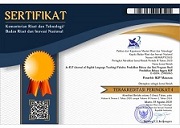EXTENSIVE READING ON ACCURACY, ACCEPTABILITY, AND READABILITY IN TRANSLATION STUDY
Abstract
The purpose of this study was to determine the effect of extensive reading on the ability to translate scientific and non-scientific articles. Translation techniques that often appear a literal translation, adaptation, discursive creation, borrowing, generalization, and calque. Whereas translation methods use a free translation, adaptation, faithful translation, word for word translation. The research method used experimental quantitative with subject 35 in class A and B. The extensive reading value of 25% had the highest score between 81-92, then 45% had average reading ability between 66-80 and 30% low or level the reading is not good with a value of 0-65. Significant between the two is 80% indicating the level of quality of translation results is good if the ER is high.
Keywords
Full Text:
PDFReferences
Bamford J., & Richard R. Day. (1998). Extensive Reading in the Second Language Classroom. Cambridge: Cambridge University Press.
Catford, J.C. (1965). A linguistic theory of translation. London: Oxford University Press.
House, J. (2018). Translation the basic. First Published. New York: Routledge.
Maryam & Kourosh (2015). The Comparative Impact of Reading Comprehension and Translation Practices on EFL Learners’ Grammar Achievement. Journal of Studies in Education. ISSN 2162-6952, Vol. 5, No.4.
Mehrdad & Masood (2015). The Effect of Teaching Reading Comprehension Skills on Translation Quality of Iranian EFL Learners. International Journal of Applied Linguistics & English Literature. ISSN 2200-3592 (Print), ISSN 2200-3452 (Online), Volume. 4 No. 1. Retrieved January 2015 from http://www.journals.aiac.org.au/index.php/IJALEL/article/view/1237/1227.
Molina & Albir. H. (2002). Translation techniques revisited: a dynamic and functionalist approach. University Autonama de Barcelona, Barcelona, Spain: Meta Jurnal XLVII.
Nababan, Nuraeni, & Sumardiono. (2012). Pengembangan model penilaian kualitas terjemahan. Kajian Linguistik dan Sastra, Vol. 24, No. 1.
Newmark, P.(1988). A textbook of translation. London: Prentice Hall.
Pham, Chuc T.K (2015). Reading Comprehension and Translation Performance of English Linguistics Students of Hung Vuong University: A Correlation Study. International Journal of English Language &
Translation Studies. ISSN: 2308-5460. Retrieved from http://www.eltsjournal.org/archive/value5%20issue3/10-5-3-17.pdf.
Pouya. F (2012). On the Effect of Translation on Promoting Reading Comprehension in ESP. Journal of Basic and Applied Scientific Research. ISSN 2090-4304. Retrieved from https://pdfs.semanticscholar.org/aa60/db69b687b48a60dae11e0798ad13da2eba0d.pdf.
Sakurai, N (2015). The Influence of Translation on Reading amount, proficiency, and speed of extensive reading. Reading in a Foreign Language, ISSN 1539-0578, Volume 27 No. 1. Retrieved April 5th from https://nflrc.hawaii.edu/rfl/April2015/articles/sakurai.pdf.
DOI: https://doi.org/10.33394/jo-elt.v6i1.2342
Refbacks
- There are currently no refbacks.
Copyright (c) 2019 Tatik Irawati

This work is licensed under a Creative Commons Attribution-ShareAlike 4.0 International License.
Jo-ELT (Journal of English Language Teaching) Fakultas Pendidikan Bahasa dan Seni Program Studi Pendidikan Bahasa Inggris IKIP is abstracted/indexed in the following databases:
Published by Faculty of Culture, Management, and Business
Universitas Pendidikan Mandalika
p-ISSN: 2355-0309 | e-ISSN : 2548-5865
email: [email protected]
 Jo-ELT (Journal of English Language Teaching) Fakultas Pendidikan Bahasa dan Seni Program Studi Pendidikan Bahasa Inggris IKIP is licensed under a Creative Commons Attribution-ShareAlike 4.0 International License.
Jo-ELT (Journal of English Language Teaching) Fakultas Pendidikan Bahasa dan Seni Program Studi Pendidikan Bahasa Inggris IKIP is licensed under a Creative Commons Attribution-ShareAlike 4.0 International License.





1.jpg)


.png)







1.png)

.png)








